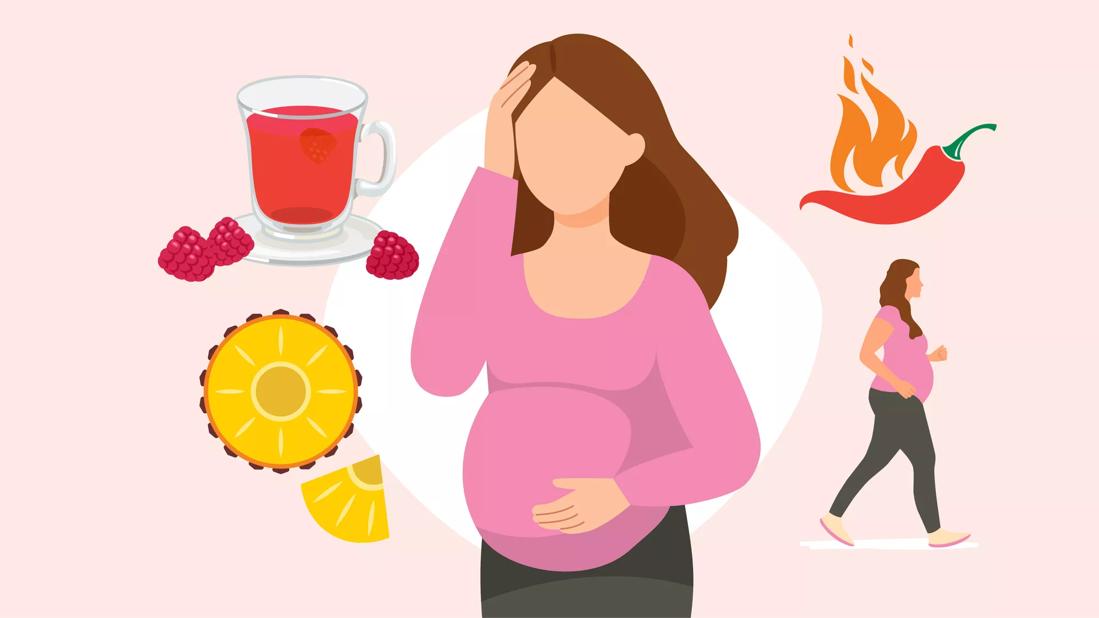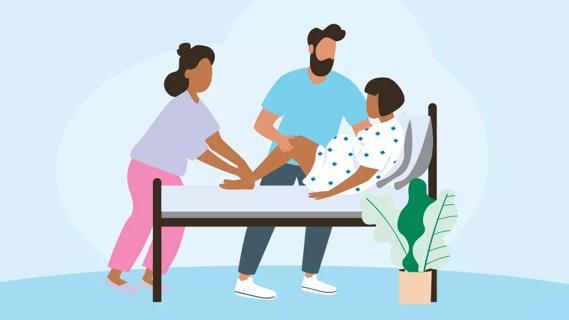Science says only one way actually works, but there are a few others that are still safe to try

You’ve hit that 39-week mark, and the moment you’ve been waiting for is just around the corner. Oh, the anticipation!
Advertisement
Cleveland Clinic is a non-profit academic medical center. Advertising on our site helps support our mission. We do not endorse non-Cleveland Clinic products or services. Policy
And the uncertainty. And the exhaustion. And, frankly, the discomfort.
It can make those last few weeks or days or hours crawl by at a snail’s pace. If you find yourself scouring pregnancy blogs and internet message boards for anything you can do to help nudge your body into labor, you’re definitely not alone.
But are there any natural ways to induce labor that actually work?
“There’s a difference between generational advice, internet myths and what’s actually been studied and shown to be helpful,” says Ob/Gyn Erin Higgins, MD.
We’ve got some bad news for you: There’s no surefire way to induce early labor short of, well, being induced. For the most part, you’ll just have to wait.
“Your body will labor when it’s ready,” says certified nurse midwife Niki Pearce, CNM. But there is one natural way of moving things along that has been shown to help.
Nipple stimulation is a natural way to increase oxytocin levels. You may be familiar with this hormone’s synthetic doppelgänger, Pitocin®, which doctors often use to induce labor. Oxytocin kicks childbirth into gear by sending signals that tell your body to start contractions and labor.
And Dr. Higgins says nipple stimulation is the only method with hard data to back it up.
Advertisement
“In one trial, more of the women who did nipple stimulation were in labor after three days than those who didn’t,” she says. “That’s a statistically significant change, and it does not appear to increase C-section rates or bad outcomes for you or the baby.”
Pearce says nipple stimulation can be especially helpful if your water has already broken but you’re not yet in labor, or if labor has started and then slowed down.
“I sometimes have women try nipple stimulation before we start Pitocin,” she says. But it should only be done under the supervision of a healthcare provider who can monitor the fetus to make sure it’s tolerating the stimulation.
What about the methods that your Aunt Linda insists will work, and the ones suggested by the well-meaning cashier at your grocery store? Some swear by natural techniques to get labor underway, but most of them are merely urban legends, with little or no research to back them up.
Here’s the lowdown on some of the most commonly recommended methods, whether they work and, critically, how safe they are. And remember: If you’re planning to try any method to jumpstart your labor, discuss it first with your healthcare provider.
This is one of the simplest ways that women attempt to get labor underway, but no study has found it to be effective.
Some also swear by “curb walking,” an uneven type of walking that is said to cause your pelvis to open. You put one foot on the street and the other foot on the curb, walking with an uneven gait. But there’s no evidence to support this one either.
That doesn’t mean that walking isn’t worth a try, as it has other health benefits — especially in the lead-up to labor.
“I encourage women to stay active during their pregnancy and walk 30 minutes most days,” Pearce says. “That helps with labor preparation, fetal positioning and endurance.”
The verdict: Walking won’t help you go into labor, but it may help you feel refreshed and invigorated — or, on the other hand, so exhausted that you stop worrying so much about when your baby will arrive.
Pineapple is loaded with an enzyme called bromelain that is sometimes used to help get the bowels moving. It hasn’t been well researched, but the idea behind this tip is that because your uterus sits right next to your intestines, it might also become irritated and start to contract.
The verdict: “If you’re not yet in labor, it’s worth a shot,” Dr. Higgins says, “but it’s also probably not going to do anything.” But it is a healthy snack that will provide a nice dose of vitamin C, fiber and manganese.
Advertisement
To be clear, we’re talking about the fruit, not a candlelight dinner and a movie!
“Eating dates may help soften the cervix and promote spontaneous labor,” Pearce says. In one study, women who ate date fruit for four weeks prior to their due date were less likely to need a formal induction.
The verdict: More research is needed, but dates are healthy enough that even if they don’t bring on labor, they’re still a worthwhile snack. Just make sure to buy whole, pitted dates, rather than the kind that come diced up and covered in sugar.
This herbal tea is rich in iron, calcium and vitamins. It won’t induce labor, but it’s been thought to be safe and potentially beneficial during the third trimester of pregnancy.
“It’s a uterine tonic, so it won’t stimulate or shorten labor,” Pearce clarifies, “but one study shows that it may help spontaneous labor occur and make labor easier.”
The verdict: There’s not enough evidence to say whether red raspberry leaf tea has a positive impact on labor. As long as you’re close to or past your due date, it’s probably OK to drink a cup a day, but check with your healthcare provider to be sure.
A few studies have found no difference in the timing of labor for women who have sex during the end of their pregnancy and those who don’t. But there’s a biological explanation that suggests it could be worth a try.
Advertisement
“Sex can stimulate the body’s natural love hormone, oxytocin, which is what causes contractions. Also, semen has prostaglandins, which can soften the cervix,” Pearce explains. “If the body is ready, orgasming can also help contract the uterus.”
The verdict: If your healthcare provider has given you the all-clear to have sex while you’re pregnant, feel free to give it a whirl, if you’re in the mood. But Dr. Higgins warns that sex during pregnancy isn’t safe for everyone.
“If you have placenta previa, bleeding or other pregnancy complications, you shouldn’t have intercourse while you’re pregnant.”
Acupuncturists insert tiny needles into specific locations on your body to try to kick-start labor. Acupressure follows the same principles but swaps the needles for firm pressure and massage, like on your hands and feet.
“There’s some data to suggest that they might be effective in starting labor, but the studies haven’t been big enough or well-designed enough to prove it,” Dr. Higgins says.
The verdict: Feel free to try, but keep your expectations low.
One of the oldest suggestions in the book says that grabbing your favorite hot sauce or getting a fiery takeout dish will hasten baby’s arrival. Not so, Dr. Higgins says.
Advertisement
“Spicy food stimulates the intestines, which may then release hormones or mediators that could stimulate contractions in the uterus,” she explains. “But it won’t put you into labor.”
As you may know from past bouts with spicy food, it can also cause diarrhea, which can lead to dehydration — and that’s never a good thing, especially not when you’re pregnant.
The verdict: Spicy food won’t help induce labor, but if you’ve got a hankering for heat, proceed with caution and keep your own standard spice tolerance in mind. Be sure you’re drinking lots of water to stay hydrated.
“Spicy foods can also cause reflux, so it’s wise to keep an antacid on hand,” Dr. Higgins advises. Options include TUMS®, Alka-Seltzer® and Pepcid AC®, for example.
If you’ve ever been told to take some castor oil to induce labor, take a pause first. Made from the little-known castor bean, this type of oil is a powerful laxative.
“Castor oil often induces diarrhea, which stimulates the intestines,” Dr. Higgins explains. “The intestines then may release hormones or mediators, which could stimulate contractions in the uterus. But neither will induce labor.”
Importantly, diarrhea can also cause dehydration that may lead to decreased blood flow going to the placenta, which can stress the fetus. Dehydration can also impact how you feel, especially as you head into labor.
The verdict: Skip it. Castor oil comes with more possible risks than benefits.
Membrane stripping, also known as membrane sweeping, can be done by your physician or midwife once you’ve hit 39 weeks and your cervix has begun to open (known as dilation). They use a finger to separate the amniotic sac surrounding your baby from the area around your cervix (aka your uterine wall).
One study showed that 90% of women who had a membrane sweep gave birth by 41 weeks compared to 75% who didn’t have the procedure.
“There are risks, like infection, breaking water or causing irregular, irritating contractions that don’t lead to labor,” Pearce warns. “But for some, it may shorten the length of pregnancy or help lower the chances of needing a formal induction.”
The verdict: Only your healthcare provider can tell you if this option is right for you, and Dr. Higgins also cautions that it’s not safe for everyone.
“For this procedure, you need to be sure you’re Group B strep (GBS) negative because of the risk of infection to the baby,” she says. “It’s also not recommended if you’re showing signs of needing to give birth via C-section.”
Let’s quickly debunk a few additional myths about ways to induce labor:
Dr. Higgins also issues a strong warning against nonprescription drugs like opioids, methamphetamines and marijuana. “While they may cause pre-term labor, they are incredibly dangerous for both you and your baby.”
It’s not always safe to give Mother Nature a nudge. Dr. Higgins cautions that to try any natural induction methods, you should be at least 37 weeks pregnant and have approval (and, ideally, monitoring) from a prenatal provider.
“Natural labor induction methods can also be risky if you’ve had a previous C-section, a placenta issue or any pregnancy-related complication,” she warns.
When you’re waiting for your baby to make their debut, the most important thing to do is also the hardest: Have patience.
“I tell patients to enjoy the last days of the pregnancy as much as possible,” Pearce says. “Sometimes, you just need a tincture of time.”
No pregnancy lasts forever. Soon enough, you’ll welcome your baby into the world, and after one look at that cute little face, you’re sure to forgive their fashionably late arrival.
Learn more about our editorial process.
Advertisement

It’s common to have a bowel movement when you’re giving birth, but your care team truly doesn’t want you to be embarrassed by it

Lamaze birthing techniques — like breathing during labor and bonding after birth — are among the most commonly taught methods in childbirth prep classes

Hypnobirthing uses techniques like breathwork and deep relaxation to encourage calm during labor and delivery

Plan ahead, pack that bag, be attentive and be an advocate

While it may be possible, it may not be safe

Use a birthing ball for pregnancy exercises and to ease labor pain

Avoid high-mercury fish and processed meat, and go easy on salt and caffeine

Ob/Gyns and midwives both care for your gynecological and pregnancy needs — which you choose depends on your health and comfort

If you’re feeling short of breath, sleep can be tough — propping yourself up or sleeping on your side may help

If you fear the unknown or find yourself needing reassurance often, you may identify with this attachment style

If you’re looking to boost your gut health, it’s better to get fiber from whole foods